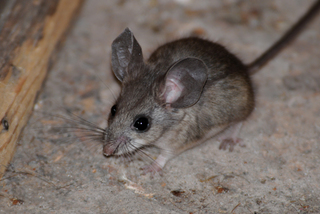
Pinyon mouse
Order : Rodentia
Suborder : Sciurognathi
Family : Muridae
Subfamily : Sigmodontinae
Species : Peromyscus truei
The Pinyon mouse is listed as Least Concern (LR/lc), lowest risk. Does not qualify for a more at risk category. Widespread and abundant taxa are included in this category, on the IUCN Red List of Threatened Species
Namings for the pinyon mouse
A young / baby of a pinyon mouse is called a 'pinkie, kitten or pup'. The females are called 'doe' and males 'buck'. A pinyon mouse group is called a 'nest, colony, harvest, horde or mischief'.Some facts about the
Pinyon mouse
Adult weight : 0.025 kg (0.055 lbs)
Maximum longevity : 5 years
Female maturity :50 days
Gestation : 26 days
Weaning : 30 days
Litter size : 3
Litters per year : 5
Interval between litters : 40 days
Weight at birth : 0.002 kg (0.0044 lbs)
Weight at weaning : 0.011 kg (0.0242 lbs)
Body mass : 0.033 kg (0.0726 lbs)
Facts about the pinyon mouse
Peromyscus truei is an omnivore that forages on the ground surface, usually amidst underbrush, but also will climb small trees to forage.
NEW MEXICO 1965: Pinyon mouse is found in the San Andres National Wildlife Refuge (USFWS, 1965) *18*.
Peromyscus truei is an omnivore that forages on the ground surface, usually amidst underbrush, but also will climb small trees to forage.
Peromyscus truei is the largest-eared New Mexican deer mouse.
The pinyon mouse (Peromyscus truei) is locally abundant in rocky areas with brushy thickets.
The pinyon mouse is rare, but has been found on the mountain.
The pinyon mouse, Peromyscus truei, is a medium-sized mouse with large ears. (Full text)
Peromyscus truei is most often confused with Peromyscus boylii, P. (Full text)
Discussion The Pinyon Mouse is an agile climber and often forages in trees for the pinyon nuts and juniper seeds that are its staple diet. (Full text)
More animals beginning with P
